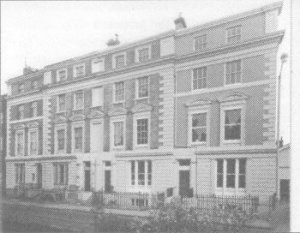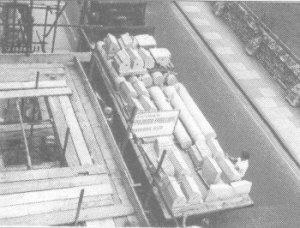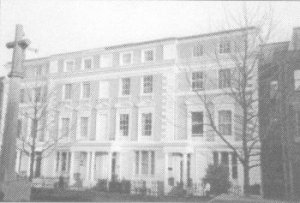Chernocke Place and Winchester's Pioneer Motorist - TrustNews Spring 1998

Chernocke Place before the porches were reinstated in 1979
Chris Webb, amateur historian and member of The Trust, gives some history of his family home and the people who lived there. (This article was first printed in the Institute of Transport Administration Journal)
An interesting piece of transport history lurks behind an elegant block of houses in Winchester. In 1897 Major General Hugh Parker Montgomery (late Kings Royal Rifle Corps, now Royal Green Jackets) became "the first person not connected with the motor industry to purchase an English built motor car". So reports the Autocar magazine recording the General's death in December 1901 at Chernocke Place, 35 Southgate Street.
General Montgomery paid the newly formed Daimler Company in Coventry £350 for his "Wagonette" car. The new company had intended this car for a director to drive from Lands End to John O'Groats for the first time, but as the General had paid for it and the delivery date was long passed Daimler released the car even though it had not been "run in". It took the General and his sister two days, with an overnight stop at The Randolph Hotel in Oxford, to drive the "Wagonette" from Coventry to Winchester, with frequent stops for railway crossing gates to be opened.
Daimler's chief foreman came to run the car in and teach the General and his groom how to drive it. Sadly, the Daimler records were destroyed in the blitz on Coventry and only a newspaper picture survives showing the car with the General.
Chernocke Place, 35 Southgate Street, is one of two blocks named after Sir Villiers Chernocke Bt (died 1779). Designed by Owen Browne Carter (1806-1859), architect also for the Corn Exchange (now the city library), Egyptian influences from his overseas visits can be seen in the interior mouldings. G E Street, architects of law courts in London, was Carter's pupil. The blocks were built between 1836 and 1845 by William White and on the Roman road -later called Goldestrete (now Southgate Street.)

The porches on a lorry in 1979
No 35 was the home first of the Lavie family from 1845 to 1873. On 18th July 1806 Captain Thomas Lavie RN protecting British shipping in HMS Blanche captured a French frigate Le Gueriere off the Faeroes without a single British life being lost. For this Lavie received a knighthood and the frigate was incorporated into the Royal Navy. To commemorate the event, Sir Thomas Lavie's brother-in-law commissioned a Flight and Barr Worcester porcelain vase. This is now in the White House and, during President John F Kennedy's time, in his personal office alongside paintings of the USS Constitution sinking HMS Gueriere en route from the West Indies in 1812. Sir Thomas' Lloyds of London urn, presented for saving the British convoy, is now in the Huntingdon Museum, Los Angeles. Sir Thomas in his will instructed his family to purchase a home and No 35 is the house they bought. His widow died in 1837 and is buried in Winchester College.
After the Lavie's left, Colonel Henry Wood C.B., Rifle Brigade and an early photographer, owned No 35 until 1919. His photographs were used to illustrate an ITV series. Henry Wood had the skull of a Russian soldier killed in the Crimea as a lampshade. He had three daughters named Olive, Hazel and Myrtle Wood!

Chernocke Place today with porches reinstated
Lady Matilda and Lady Amelia Montgomery, daughters of the 5th Earl of Macclesfield, rented no. 35 in 1875. Major General H P Montgomery was Lady Matilda's son and served in India and South Africa. He always rented a room, paying his mother £40 a year, to ensure he had a vote. At one time he commanded the Rifle Barracks and eventually retired from York to Winchester, after the deaths of his mother and aunt, to live with his surviving sister in no. 35. As well as being an enthusiastic motorist, General Montgomery was also a director of the local electricity company and no. 35 was one of the first houses in the city to be lit by electricity. Many of the old wooden DC conduits remain, albeit with a modern wiring system installed. He was indeed "the model of a modern Major General" and his motoring exploits are commemorated by a plaque on the nearby modern Anglo St James House which stands on the site of stables where the Daimler was garaged. Sadly, no further details of the car have been found and it must be assumed it was scrapped as registration marks did not come into use until 1903.
After General Montgomery's death, Dr H Godwin MB BS FRCS rented no. 35 as a home and surgery on returning from the Boer War. Between 1912 and 1918, no. 35 was a boarding house before becoming flats and offices. In 1966 the whole block was looking very much the worse for wear when my parents purchased no. 35 as a home. Since then, the house has gradually been restored to something like its former splendour. In 1979, the frontage was cleaned and porches reinstated. This was organised by the Trust to commemorate the Queen's Jubilee. The fine interior ceiling mouldings have also been cleaned to reveal the 1840 details.
So, as you join the traffic in Southgate Street, remember the General who helped start the motoring industry by being the first member of the general public actually to acquire an English built motor car.
